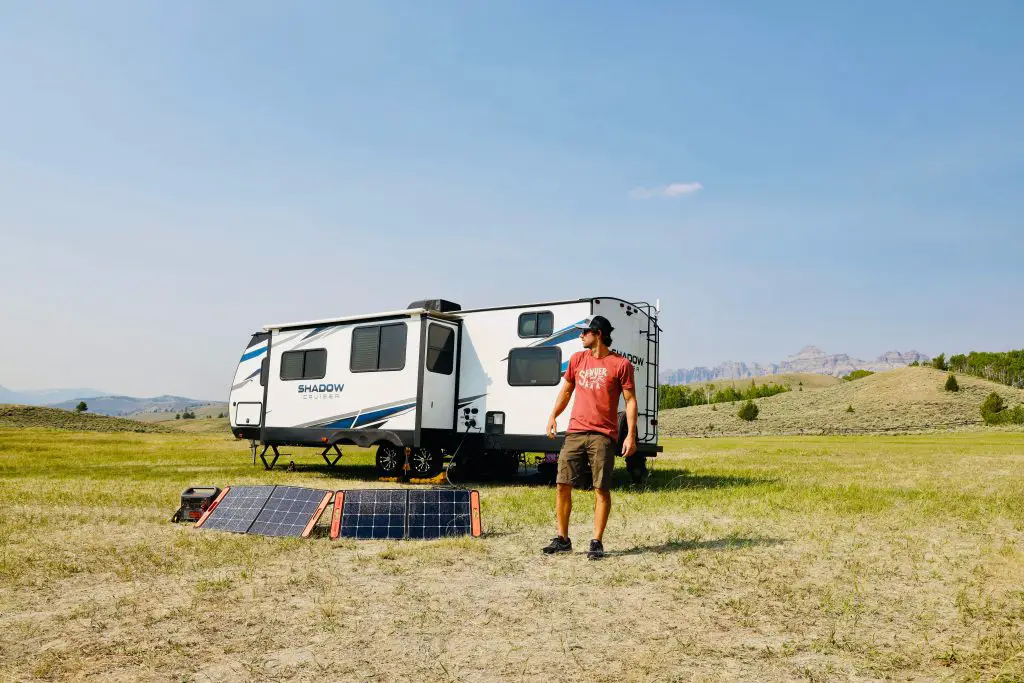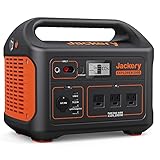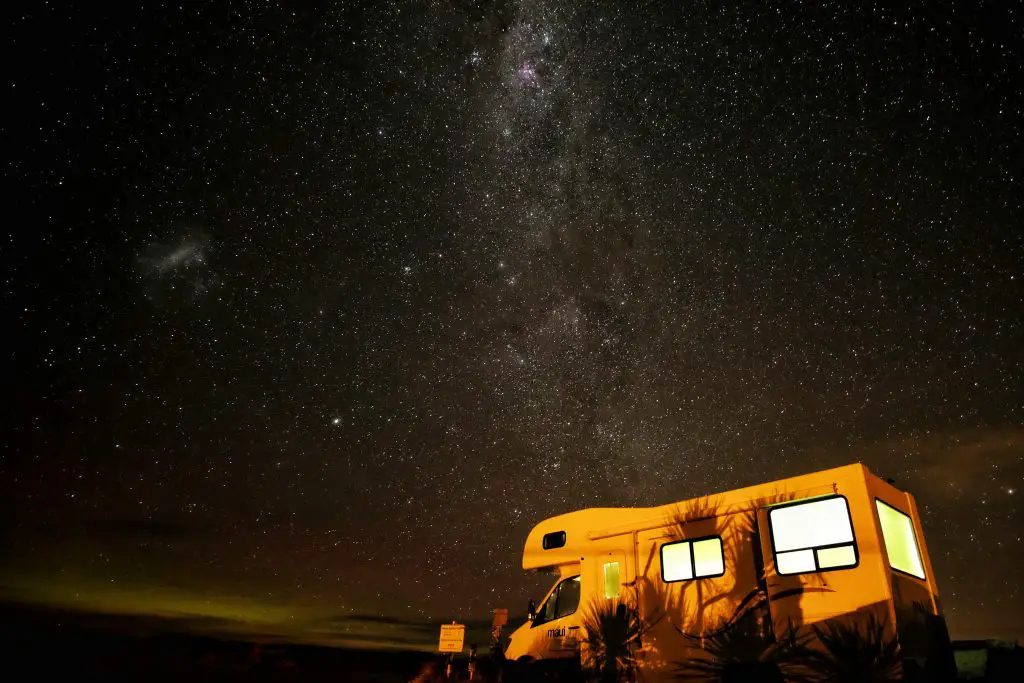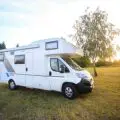Hey! This site is reader-supported and we earn commissions if you purchase products from retailers after clicking on a link from our site.
As the world moves away from a fossil fuel-powered energy grid, technology brings exciting new products to market every year. Here’s something you couldn’t buy five years ago, a “solar” generator. These incredible little boxes combine all the necessary parts of an off-the-grid electrical system, so you can have power to any appliance you want anywhere you want to take it.

Of course, there are limitations to solar generators. You need to know exactly what these devices do and calculate your energy needs carefully, so you don’t wind up with one that is too small. But with a little research, these generators provide an outstanding option for off-grid living in boats or RVs. Imagine–one device could replace a mountain of research, system design, wiring, and technical parts needed to build a system from scratch.
Here’s a look at these amazing little boxes that can make living on your own terms so much easier.
| Image | Title | Price | Prime | Buy |
|---|---|---|---|---|
 | Jackery Portable Power Station Explorer 300, 293Wh Backup Lithium Battery, 110V/300W Pure Sine Wave AC Outlet, Solar Generator (Solar Panel Not Included) for Outdoors Camping Travel Hunting Blackout | PrimeEligible | Buy Now | |
 | Jackery Portable Power Station Explorer 1000, 1002Wh Solar Generator (Solar Panel Optional) with 3x110V/1000W AC Outlets, Solar Mobile Lithium Battery Pack for Outdoor RV/Van Camping, Emergency | Prime | Buy Now | |
 | Goal Zero Yeti 1500X Portable Power Station, 1,516 Watt-Hours, Solar-Powered Generator with USB-A/USB-C Ports and AC Outlets (Solar Panel Not Included), Camping and Emergency Portable Generator Power | Prime | Buy Now | |
 | BLUETTI Portable Power Station AC200MAX, 2048Wh LiFePO4 Battery Backup, Expandable to 8192Wh w/ 4 2200W AC Outlets (4800W Peak), 30A RV Output, Solar Generator for Outdoor Camping, Home Use, Emergency | Prime | Buy Now | |
 | EF ECOFLOW DELTA Pro Portable Home Battery(LiFePO4), 3.6KWh Expandable Portable Power Station, Huge 3600W AC Output, Solar Generator (Solar Panel Not Included) For Home Backup, RV, Travel, Outdoor Camping | Prime | Buy Now | |
 | Goal Zero Yeti 6000X Portable Power Station for Homes, 6000 Watt-Hours, Solar-Powered Generator with USB-A/USB-C Ports and AC Outlets (Solar Panel Not Included), Portable Emergency Power Supply | Prime | Buy Now |
Solar Generator 101 — All About Off-The-Grid Electricity
What is a Solar Generator?
Solar generators are battery banks that you can charge from solar panels, usually sold separately. They provide power outlets for use anywhere. You can use it simply as an enormous rechargeable battery until you get home, or you can use solar panels to recharge it when off-the-grid.
These items are also sometimes called portable power stations.
For years, RV and boat owners have been making their own off-the-grid energy systems. Some solar panels on the roof, a powerful battery bank down below, and a ton of other stuff make these systems tick. Setting them up isn’t rocket science, but it is a major investment in money and time. Plus, they usually require running wires and cutting holes in the roof.
The solar generator combines all the different parts of that system and puts them in one small package. It is essentially a large battery bank, much like those pocket-sized ones that will top up your phone a few times. But in the case of these solar generators, they have enough juice to run a blender or a mini-fridge overnight.
The real beauty of the solar generator is in its integrated components. Not only does it have a battery bank, but it also has standard household 120-volt wall outlets to run home appliances. They also have USB outlets for your devices and a 12-volt automotive outlet for travel accessories.
And while they can power devices using all of these outlets, they also have numerous charging options. For example, you can plug them into the wall outlet at home or in your car while driving. Or, if you have solar panels, you can plug the panels directly into the generator to top it off when there is sufficient sunlight. In addition, some offer faster charging if you plug in more than one charging source.
Inside this single box are a lithium battery bank, chargers, solar controller, AC power inverter, and all the safety equipment and protection circuits necessary to make it work safely.
What Are Some Uses for a Solar Generator?
What exactly do you want to power and the output and storage capacity of your generator go hand-in-hand.
Small-watt generators have smaller batteries and, therefore, smaller energy outputs. Not only will the batteries drain quicker, but they can also only power small appliances. For our purposes, a small-watt generator is anything less than 750 watts. These are appropriate for recharging laptops, cameras, phones, televisions, radios, or LED lights.
Mid-sized units have between 750 and 1,500 watts. These provide enough power to run kitchen appliances and other items that use a lot of power, but not for very long. For example, hot plates run on 1,200 to 1,500 watts of electricity. But, even if that’s all you’re running, a battery pack of that size would only function for one hour.
So these battery banks are best reserved for things that use a lot of power, but not for very long. Blenders, hair dryers, power tools, and maybe an Instant Pot pressure cooker if you are careful.
Solar generators with more than 1,500 watts are large enough to run a powerful appliance for hours at a time. But you have to do the math. It’s easy to underestimate your power demands and quickly run down a battery bank, especially in an off-grid situation where you don’t have access to a charging method.
On the other hand, these generators can run things like refrigerators, hot plates, electric grills or griddles, or power tools for hours at a time.
Solar Generator Alternatives
If you want to live your life unplugged, you have a few options. Each option looks a little different and appeals to different folks. Your style of getting away from it all will determine the sort of solar generator you might want. But all types of adventurers can benefit from these cool devices.
Group 1: Use Less Power
Imagine going camping the old way–out of a tent. No glamping allowed–and maybe you’re going to a hike-in spot.
What are your power options? Well, there really aren’t any. If you’re in your car, you might be able to charge a cell phone or device from a USB or car charger. You can use battery devices, but what if you’re staying awhile? How will you recharge things? Maybe you need to conserve your phone battery by only switching it on a few times a day (oh, the horror!).
This type of living is all about monitoring your energy usage and reducing it. You’ve only got so much, so you only use so much.

Group 2: Burn Some Gas (or Diesel)
So you’re in the boondocks and need electricity, but there’s no plug. You could opt to run a gas generator. Portable generators can produce between 1,000 and 3,000 watts of power–enough to recharge nearly any type of battery and run any appliance you need. They can run home refrigerators or any power tool you can dream up.
But they aren’t without their drawbacks, of course. Generators are noisy and smelly. Nothing ruins the peace and quiet of the great outdoors like the smell of exhaust fumes and the mind-numbing drone of a generator.
Gas generators carry a risk of carbon monoxide poisoning and must be set running away from your camp. Even a super-quiet, enclosed diesel generator in a Class A motorhome or yacht can get pretty darn annoying after a while. And finally, the fuel and maintenance costs to keep them running an hour after hour aren’t insignificant.
Group 3: Go All Solar (or Wind)
So you want the power, but you don’t want the noise and stink of a generator. Solar is now a viable option for nearly every user, but it requires some knowledge and planning to make an effective system.
Renewables like solar and wind provide electricity when the sun is shining, or the wind is blowing. But all other times, the power must come from a battery bank.
Luckily, there have been great advances in battery technology in the last decade. There are now batteries that can be drained and charged repeatedly without limitations, unlike traditional lead-acid batteries that need to be charged up after every use. This is perfect for use with renewables since you never know how much power you will get each day.
Building an effective off-the-grid solar system means tabulating precisely how many watts of energy you use every day and then planning to make at least that much or more. Running the modern home takes a shocking amount of power, but most RVs and boats require substantially less.

Understanding Watts vs Watt-Hours
A vital distinction when shopping for a solar generator is the difference between watts and watt-hours and precisely what each means.
The watt is a measure of electrical power. Watts are calculated by taking the volts available and multiplying them by the amperage (current).
A watt is a measure of the total energy used, but it is a momentary number. For example, a 200-watt refrigerator might sound efficient, but what if it runs 20 hours per day? Wouldn’t a 350-watt fridge that only runs 10 hours per day be better?
That is the difference between watts and watt-hours. If you take an appliance’s power and multiply it by how many hours it operates daily, you have the watt-hours.
If you’re planning an overnight trip and want to know if your solar generator has enough power, you’ve got to look at the watt-hours. The watt-hours apply to the battery (the total energy it can supply) and to each appliance.
Solar Panels – Power Output
Similarly, solar panels are rated based on how many watts they produce. But a solar panel does not make that power 24 hours per day. In fact, it seldom makes its rated power at all.
A solar panel will make its rated power in watts when it directly faces the sunshine at a right angle with no shadows or obstructions. Any bit of shade or any clouds in the sky will affect it dramatically. Plus, the angle of the sun is seldom optimum. If your panels are fixed to your RV’s roof, they may never be perfect. And then, as the sun moves in the sky throughout the day, the solar output will wax and wane naturally.
As a result of all of that, you need to put lots of fudge factors into any system that you want to support your off-grid energy needs. It must provide enough power during those peak solar production times to charge your batteries enough to last the rest of the time.
How to Setup an Off Grid Solar Generator System
Battery Tech
Nearly all solar generators on the market today use either lithium nickel manganese cobalt (NMC) or lithium-iron-phosphate batteries (LFP).
There are many reasons to love lithium-iron-phosphate batteries, also called LiFePO4 or LFP batteries. First, they can be deeply discharged, in some cases below 10 percent of their capacity, without causing any damage. They can also take huge charging and discharging currents and run big appliances or be recharged very quickly.
These batteries have become very popular with boat and RV owners thanks to brands like Battle Born and Relion. This is because they are reliable, safe, and very efficient. Plus, thanks to their popularity, they have also become affordable.
Compared to other lithium battery technologies, all of which are generically called “lithium-ion,” LiFePO4 batteries are less prone to thermal runaway, which can lead to fires. As a result, these batteries are generally considered to be as safe as the common lead-acid batteries already found in cars and RVs worldwide. But just like those old-tech batteries, precautions and proper system design are required to ensure safe operation.
This is another reason that portable generators are a great idea. No longer is it up to the boat or RV owner to design a system and ensure a trouble-free and safe setup. Instead, these generators are designed with their own safety systems built-in to ensure the batteries will not be over or undercharged.
Other battery technologies are also used in portable power stations, including Lithium NMC, or Nickel Manganese Cobalt. These batteries also perform very well, but they are generally considered more appropriate for home backup solutions as their lifespans are shorter than LiFePO4. In addition, NMC batteries are a bit cheaper than LFP equivalents, but since LFP batteries are safer and last longer, the value goes to LFPs.
If you’d like to learn more about how lithium works and the six main types of lithium-ion batteries, Dragonfly Energy has an excellent post about it.
How Many Watts Solar Generator Do I Need?
Picking the right solar generator is all about finding the one with the right amount of storage and output. These numbers are often very similar.
Output Capacity and Ports
Output watts are measured in two ways; continuous and peak. Continuous output can be provided until the battery is completely drained. Peak, however, can only be provided for a short time- maybe two or three minutes.
Peak power is only useful if you are contemplating using a power tool that switches on and off quickly, like table saws or similar items. They’re also good if there’s a chance that more than one thing might come on at a time, like a hot plate and the fridge.
Generally, you want to ensure your generator has enough continuous output to meet your needs. Thanks to a built-in inverter, power is supplied via one or more 120-volt AC power outlets. There are also DC power options, like a 12-volt car outlet and 5-volt USB charging ports. The precise number of ports and configurations varies depending on the model of the solar generator.
Charging Capacity and Options
Just like the output varies, so does the input (charging) capacity. The larger the battery, the more power it can take at once. And the more power a battery bank can take, the faster it can recharge.
Nearly all solar generators are set up to be recharged via a standard electrical outlet or a car charging port. To be branded as a solar generator, it should also have a port dedicated to plugging in a solar panel. Solar panels need their output regulated to charge a battery, so these generators have built-in solar controllers to make setup easy.
Solar Panel Setup
Most companies selling solar generators also sell solar panels to plug into them. In many cases, you can purchase your portable power station as a kit that includes matching solar panels.
The biggest question is exactly how much solar you need to buy. The more solar you have, the quicker your battery will recharge. Quick recharges are important because when you have sunshine, you want to use as much of it as possible.
The solar panels sold with these portable systems are lightweight folding panels in plastic carrying cases. This is great for car camping or any place where you might make a temporary camp.
However, if you want to install a solar generator in your travel trailer or boat, you might want to consider installing permanent solar panels. You should be able to buy any size and shape of the solar array you like and use it to recharge the portable power station. Just make sure that your solar array’s total voltage and amperage are within the capabilities of your unit’s charging port.
Best Brands of Solar Generator
Jackery
Jackery, a California company founded in 2012, was a true pioneer of the solar generator sector. They’re the number one producer of portable power units. The company does nothing else–they only sell power units and bundles with solar panels. They’ve received numerous innovation awards for their green products and designs.
Jackery offers their Explorer line of portable power stations in wattages ranging from 160 to 2,000. Their SolarSaga panels come in folding 60, 100, or 200-watt arrays that you can combine to increase power to the Explorer. Their solar generators are bundled sets of an Explorer power station and solar arrays of various wattages.
Bluetti
Bluetti sells a product line similar to Jackery but with more options for expansion and sizes. Their portable power stations come in sizes from 700 to 3,000 watts and use longer-lasting LFP batteries. They also sell home backup batteries and batteries designed to expand the capabilities of your portable power station. Like the other companies, they sell either their standard power units or kits that include solar panels.
Goal Zero
Goal Zero makes a broad ecosystem of power stations and solar panels, both for mobile and home use. They pride themselves on offering great customer service and building quality, premium products that will last. Their power stations are all-metal with no flimsy plastic cases.
Goal Zero is one of the only companies with products specifically geared towards campers, from overlanders to RVers and van lifers. Their Yeti portable power stations are available with optional vehicle integration kits that allow quick charging from your alternator.
Goal Zero sells portable power banks with sizes ranging from small backpacking-friendly units to an insane 10,800 watt-hour home backup system. The standard Yeti power stations come in sizes from 150 to 6,000 watts.
Things to Look For With Solar Generators
Battery Capacity and Total Wattage Offered
The single deciding factor for which solar generator is right for you is its capacity. How much battery storage does it have (in watt-hours), and what is the biggest appliance it can power (in watts)?
In other words, you can’t run your fridge on a 300-watt unit for very long, and you don’t need a 3,000-watt unit to charge a laptop. Look realistically at the biggest power consumers you want to use. More watts means more battery, which is these units’ single most expensive element. Their cost is directly related to the size of the battery bank.
Outlet Options
Most portable power stations come with every outlet option you could want. Most come standard with:
- Multiple 120-volt AC outlets (house power)
- Multiple USB 5-volt outlets
- 12-volt vehicle charging port
- USB-C PD high-power output for laptops and other compatible devices
Solar Generator Setup and Charging Options
How will you recharge your unit? Will you use solar, your vehicle’s alternator, a wall outlet at home, or a combination of all three? Some units allow for faster charging if you provide multiple sources (i.e., solar + wall outlet or vehicle + solar)
If you’re going to attach a solar array, make sure the unit has the capacity. The batteries will limit the amperage of solar they can take, so a small unit will not accept as much solar as a large unit.
Pure Sine Wave Inverter
You will need a unit with a pure sine wave inverter to run some sensitive electronics. Most of these units fit the bill but double-check. Some things, like microwaves and computers, will have issues with cheaper inverters.
Expansion Capability
You can expand some units by connecting two units in parallel. Others, like the Bluetti units, can be expanded by buying more external batteries.
Portability
How easy is carrying your unit (if that’s something you plan to do)? Many have handles, and some have wheels to roll them like a cooler. The overall weight will depend on the size of the battery bank; the more power it has, the heavier it will be.
Best Solar Generator for Off Grid Living – Tiny Homes, Boats, and RVs
Jackery Solar Generator 300
If you’re looking for a small, portable battery pack to take with you on shorter adventures, you can’t go wrong with the Jackery Explorer 300. Jackery more-or-less invented the portable power station, and the 300 has all the right features to make it really useful. If you’re looking for even less, 160 and 240-watt models are available.
These small power stations are perfect if you’re just looking to charge a laptop or digital camera frequently. It won’t run power tools or coffee makers, but it will keep all your electronics topped up for long trips. That makes it great for camping expeditions or minimalist living in a van or on a boat.
Specifications
- Capacity (in Watt-Hours): 293 Wh
- Battery Type: Lithium NMC
- Inverter Continuous Load: 300W
- Inverter Peak Load: 500W
- Number of 120-Volt AC Outlets: 2
- Other Outlets: 12V Car outlet, USB-A, USB QC 3.0, USB-C PD
- Max Solar Input: 100W
- Unit Weight (in Pounds): 7.1
- SPEED UP YOUR RECHARGEABILITY: It takes only 2 hours to recharge 80% battery of the power station through the wall outlet and 60W PD USB-C port simultaneously. You can also recharge your power station with an AC adapator when at home, through the car outlet during a road trip or simply use a Jackery SolarSaga 100.
Prices pulled from the Amazon Product Advertising API on:
Product prices and availability are accurate as of the date/time indicated and are subject to change. Any price and availability information displayed on [relevant Amazon Site(s), as applicable] at the time of purchase will apply to the purchase of this product.
Jackery Explorer 1000
With its sleek design and convenient carry handle, the small Jackery Explorer 1000 is perfect as a backup power source for a couple of days on the road. It has enough power to recharge laptops and run computers or televisions. It could even run a mini-fridge or coffee maker if you give it some solar or vehicle top-ups.
The Explorer 1000 can be upgraded with two SolarSaga 100 folding solar panels if you want some solar. In addition, it has a built-in LCD screen to give you state of charge information.
Specifications
- Capacity (in Watt-Hours): 1,002 Wh
- Battery Type: Lithium NMC
- Inverter Continuous Load: 1,000W
- Inverter Peak Load: 2,000W
- Number of 120-Volt AC Outlets: 3
- Other Outlets: 12V Car outlet, 2x USB-C, 2x USB, Quick Charge 3.0
- Max Solar Input: 126W
- Unit Weight (in Pounds): 22
- MASSIVE CAPACITY & IMPRESSIVE ENDURANCE: With the 1000W wattage and 1002Wh capacity, this Explorer features 3 PURE SINE WAVE AC outlets, 2*USB-C, and 1*Quick Charge 3.0 port. It will power your full-size refrigerator, TV, mini cooler, electric grill, fan, and more for your outdoor and home needs.
Prices pulled from the Amazon Product Advertising API on:
Product prices and availability are accurate as of the date/time indicated and are subject to change. Any price and availability information displayed on [relevant Amazon Site(s), as applicable] at the time of purchase will apply to the purchase of this product.
Goal Zero Yeti 1500X
The Yeti 1,500 is about as good as it gets for many users. Its sturdy metal design is compact and easy to manage. It has a lot of power ports and can accept a huge array of solar. So if you’re looking for the best compact portable power station for a small camper or van, this is probably it.
Specifications
- Capacity (in Watt-Hours): 1,516 Wh
- Battery Type: Lithium NMC
- Inverter Continuous Load: 2,000W
- Inverter Peak Load: 3,500W
- Number of 120-Volt Outlets: 2
- Other Outlets: 12V Car outlet, 2x 6mm 12V (120W), 12V high power (360W), USB-C PD (60W), 2x USB-A (12W), USB-C (18W)
- Max Solar Input (in Watts): 600W
- Unit Weight (in Pounds): 45.64
- RELIABLE PORTABLE POWER: With a lithium-ion battery at its core, the Goal Zero Yeti 1500X equips you with safe, clean, portable power for camping, tailgating, off-grid events, workshops, and emergency home backup.
Prices pulled from the Amazon Product Advertising API on:
Product prices and availability are accurate as of the date/time indicated and are subject to change. Any price and availability information displayed on [relevant Amazon Site(s), as applicable] at the time of purchase will apply to the purchase of this product.
Bluetti AC200MAX
A few things make the Bluetti noteworthy for RVers and boaters. For one, Bluetti power stations are amazing in their expandability. You can keep adding more and more capacity by purchasing extra battery packs. Of course, your inverter’s overall power output won’t improve, but your devices can run for longer periods.
Next, the Bluetti has a 30-amp RV power outlet (NEMA TT-30). This is a fabulous upgrade since it means you could plug your shore power cord in, charge your RV batteries, or use its converter for 12V accessories. Or, use the RV’s internal plugs while leaving the solar generator outside. This greatly simplifies any wiring or setup you’d have to do, making living in the RV more or less like living plugged in, but you can go anywhere.
The solar controller in this power station is also more robust than many and will accept voltages ranging from 10 to 145 volts–up to 900 watts total. Finally, the Bluetti uses more advanced LiFePO4 batteries, which will give more than 3,500 cycles at an 80-percent depth of discharge. That’s a lot of power.
Specifications
- Capacity (in Watt-Hours): 2,048 Wh (expandable to 8,192 Wh with extra batteries)
- Battery Type: Lithium LFP
- Inverter Continuous Load: 2,200W
- Inverter Peak Load: 4,800W
- Number of 120-Volt AC Outlets: 4x 20A + 1x 30A RV plug
- Other Outlets: 12V Super DC, 4x USB-A, 1x USB-C, 1x 12V car outlet, 2x DC5521
- Max Solar Input: 900W
- Unit Weight (in Pounds): 62
EF Ecoflow Delta Pro 3.6 KWh Home Power Solar Generator
Are you looking for a complete power solution for your entire motor home? The EF Ecoflow has the amazing option of being able to plug in a 30-amp power cord, meaning you can have your entire camper running off this box. In essence, it’s powerful enough to function as a large gas generator and run everything in your campers through its shore power cord.
It also has the most powerful inverter found on any portable device to match that. With a 3,600-watt capacity, there isn’t much that this inverter can’t handle. It can do your fridge, power tools, and kitchen appliances too. And unlike other portable solutions, EF Ecoflow uses more advanced and longer-living Lithium Iron Phosphate batteries.
One problem with such a big battery bank is recharge time. However, you can recharge quickly thanks to the built-in multiple charging options. It will recharge at EV station chargers in under two hours, or you can recharge using conventional solar, wall outlets, or carports. You can even connect multiple EF Ecoflow batteries in parallel if you need more power backup. You can expand your system up to 25 kWh with extra units.
Specifications
- Capacity (in Watt-Hours): 3,600 Wh
- Battery Type: Lithium LFP
- Inverter Continuous Load: 3,600W
- Inverter Peak Load: 7,200W
- Number of 120-Volt AC Outlets: 4x 20A sockets + 1x 30A socket
- Other Outlets: 2x USB-A, 2x USB QC, 2x USB-C PD (100W)
- Max Solar Input: 1,600W
- Unit Weight (in Pounds): 84
Goal Zero Yeti 6000X
The Yeti 6000X is one of the most powerful portable power stations on the market. And like all of the Yeti portable power stations, the robust metal case can stand up to years of use.
To upgrade to a complete solar generator solution, you can add up to 600 watts of solar via the 6000X’s high-power charging port. It accepts anywhere between 14 and 50 volt DC power, which should accommodate any solar array you might want to set up.
If you need even more power, check out Goal Zero’s line of home backup power banks. In addition, you can add stationary batteries to upgrade the Yeti for multi-day home power in the event of outages or for off-grid use.
Specifications
- Capacity (in Watt-Hours): 6,071 Wh
- Battery Type: Lithium NMC
- Inverter Continuous Load: 2,000W
- Inverter Peak Load: 3,500W
- Number of 120-Volt AC Outlets: 2
- Other Outlets: 12V Car (160W), 2x 6mm 12V (120W), 12V High Power (360W), USB-C PD (60W), 2x USB-A (12W), USB-C (18W)
- Max Solar Input: 600W
- Unit Weight (in Pounds): 106
- PROFESSIONAL-GRADE POWER: Equipped with 6,071 Watt-Hours and seven versatile ports for power-hungry devices and appliances, the Yeti 6000X can power essential home circuits, RVs, trailers, worksites, and more
Prices pulled from the Amazon Product Advertising API on:
Product prices and availability are accurate as of the date/time indicated and are subject to change. Any price and availability information displayed on [relevant Amazon Site(s), as applicable] at the time of purchase will apply to the purchase of this product.
Should You Get a Solar Generator?
Solar generators are going to become more and more common. For RVers and boaters, these magic boxes offer a plethora of options. Imagine using these batteries as your domestic house bank to meet your ordinary power demands. You could leave the vehicle’s stock 12-volt system in place and easily wire up a solar array. That would mean that instead of several weeks of outfitting and setting up, you could be on the road in a day or two.
As we demand more and more from our power systems, a portable power bank like this makes a lot of sense. Is it worth installing $5,000 worth of lithium batteries, solar panels, and inverters into a 30-year-old $10,000 trailer or sailboat? It’s certainly not going to magically make it a $15,000 trailer or sailboat! However, a system like this means you can take it with you, either when you sell that vehicle or just to use the system for a weekend camping adventure.
There will always be folks who need a built-in, high-capacity electrical system. But portable solar generators are a great way to get all the capability with a fraction of the trouble.
FAQs (Frequently Asked Questions)
What size generator do I need for off-grid?
Generator size should be matched with power demand. The generator should have enough capacity to power everything you intend on running. The best thing is to do a quick tabulation–how many watts does each appliance use, and how long does it run? Sum them up and find the total energy you need from your generator.
Which solar system is best for home, on-grid or off-grid?
Most off-the-grid installations are designed to charge an independent battery bank, either a portable one like the Jackery solar generator or an installed one, as in a boat or RV. These are the best systems when getting power from the grid is not an option. On the other hand, home on-grid solar systems are designed to make electricity and feed it back to the grid. You may be eligible for a rebate on your utility costs and other tax benefits in some areas. Check with your area’s electrical provider and city government for precise details.
What is the off-grid solar power system?
An off-grid solar power system is completely independent of any utility company. Systems like this have solar arrays that charge battery banks to provide power 24 hours per day. The size of the solar array and battery bank varies depending on how much electricity needs to be provided.










